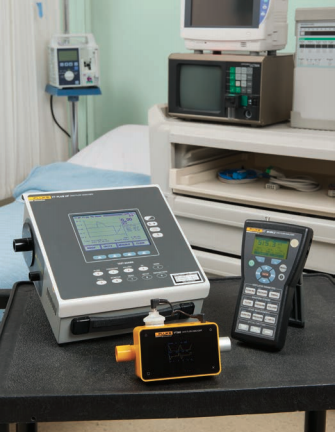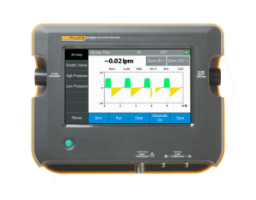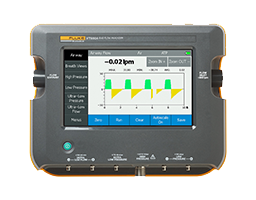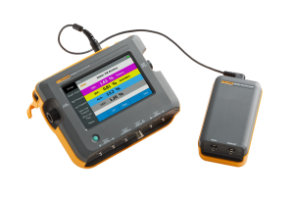Getting the most for your money: gas flow test equipment
 Ventilators, aspirators, insufflators, gauges, flowmeters, calibration syringes, medical gas and vacuum outlets, surgical wound and chest suctioning devices. Each of these exert a positive or negative pressure and create a positive or negative flow of gases (including room air). How many of these devices reside in your inventory, and need to be tested? How frequently must these devices be tested? How long does it take to set up and perform the required tests? What test equipment will you use? What are you doing to make test documentation, troubleshooting, and repair quick, easy and cost-effective? If you haven’t considered these questions, we recommend you do.
Ventilators, aspirators, insufflators, gauges, flowmeters, calibration syringes, medical gas and vacuum outlets, surgical wound and chest suctioning devices. Each of these exert a positive or negative pressure and create a positive or negative flow of gases (including room air). How many of these devices reside in your inventory, and need to be tested? How frequently must these devices be tested? How long does it take to set up and perform the required tests? What test equipment will you use? What are you doing to make test documentation, troubleshooting, and repair quick, easy and cost-effective? If you haven’t considered these questions, we recommend you do.
Documentation of performance test results and statistical trending of failures is at the heart of medical device quality assurance best practices. Ensuring the performance of the devices against manufacturers’ specifications, and even more importantly, ensuring proper function of these devices under conditions simulating real-life use, improves a clinician’s ability to deliver high quality patient care.
Another important consideration is the impact to your budget in terms of acquisition cost and per-use cost of the test equipment necessary to properly evaluate performance and functionality. What is the impact to the hospital’s capital medical budget when deciding between high quality and low quality equipment? What is the impact to your test equipment budget? All these factor into the selection process and impact your test equipment budget.
Gas flow device fleet
Are you responsible for the management of the critical medical devices that control pressure and/ or flow? These devices can include:
- Medical gas outlets
- Pressure gauges
- Flow meters
- Suction devices
– Tracheal suctioning
– Suction/vacuum regulators (e.g. Ohmeda intermittent suction regulators)
– Aspirators
– Wound/chest/abdominal suctioning
– Vaccum curettage devices
– Intermittent suction pumps (including thermotic designs)
- Surgical devices
– Laparoscopic insufflators
– Tourniquets
– Electrosurgery units with Argon gas flow (pump performance)
- Patient monitors
– NIBP pumps
– ETCO2 sample pumps
- Ventilators (including anesthesia ventilators and anesthesia machines)
– CMV (conventional mechanical ventilation)
– HFCMV (high frequency conventional mechanical ventilation)
– HFOV (high frequency oscillatory ventilation)
– HFJV (high frequency jet ventilation)
These are just a sampling of gas flow and/or pressure-producing devices found in hospitals today. If you could acquire a single gas flow analyzer capable of measuring pressure, flow and oxygen concentration, this means one device could test each and every piece of gas flow and/or pressureproducing equipment in a hospital. Imagine the return-on-investment your department would see for each dollar invested.
Additionally, if used on all gas flow and/or pressure-producing devices, this versatile analyzer would be used all year long instead of just sitting on the bench, thereby improving efficiency and generating extra savings.
Sample purchase justification
Think your shop could benefit from a versatile gas flow and pressure meter? We’ve got some advice for how to justify this kind of purchase.
Early development of specialized test tools for the biomedical technician were dependent upon a set of individual pressure gauges and flowmeters that had been set up on a special bench specifically designed for gas flow device testing. These gauges and flowmeters, when purchased to meet the range and accuracy requirements, were not inexpensive. When new devices were added to the inventory, the bench would have to be expanded to meet the correct range or accuracy required to match the manufacturers’ specifications.
The bench could not be moved and still ensure the gauge and flowmeter accuracy because the flowmeters had to be absolutely level and plumb. This required devices to be brought to the special bench rather than perform inspections where the devices were stored (Respiratory Care storage spaces, OR storage spaces, or Central Supply/SPD). These problems necessitated a better solution. A test equipment solution needed to be capable of the wide range of pressures and flows necessary to complete testing of all the medical gas devices in inventory, and also whose total footprint could be kept small enough to fit in an equipment cart. Device testing where stored could be performed and batch inspections could be processed like an assembly line. Portability, versatility, and economy were necessary.
The RT-200™ (made by Timeter, acquired by Allied Healthcare and no longer manufactured), was the only such pressure and flow test device available at the time that met all these criteria. It had several inlet and outlet ports for measuring flow and pressure of gases. It also had several functions for high-range flow and low-range flow, high-range pressure and low-range pressure. The unit was so expensive that the acquisition cost and the cost of annual calibrations needed to be spread across more devices, while maintaining NIST traceable inspections.
The RT-200 also had limitations. It could measure flow in only one direction at a time, which did not allow the substantial time savings required for ventilator performance testing. It could not provide a graphical print-out of the measured data. Even obtaining a text/numericonly print-out was not easy. The acquisition cost at the time was about $2,500. If ventilators were the only devices it was used for, and there were only 12 ventilators, the cost per device tested would be $200 per inspection. By spreading the acquisition cost across more devices, for example 120 devices, the cost per inspection dropped to $20. The break-even point would have been reached much more quickly and the utilization of the RT-200 would have been much more frequent, shortening the learning curve and improving device expertise. The RT-200 sufficed until the purchase of a Servo 900C TM ventilator, which performed at 120 breaths per minute.
Current capability
Today, there is an opportunity to select test equipment for gas pressure and flow producing devices that is even more capable than the RT-200. Fluke Biomedical, formerly Bio-Tek™, launched the VT Plus™ in 2000 as a replacement for its very reliable VT1™ and VT2™ ventilator testers. Now the VT Plus HF and the VT305 are considered viable replacements for the RT-200. A table is included below to show the key features and functionality of both devices that meet the needs of a wide range of medical gas flow/pressure devices. The VT Plus added the capability of an integrated large (waveform) graphical display, easy onebutton graphical and/or text/numeric printing, and special PC software application (that allowed the graphical and/or text/numeric data to be stored as an electronic file, as well as expanding the number of printers with which it was compatible). The pressure and flow ranges were broad enough to allow for uni and bidirectional flow. This allowed for continuous flow devices to be tested as well as ventilators of all kinds. The bidirectional flow capability allowed it to be connected to a ventilator at the patient breathing circuit y-piece and allowed collection of all ventilator parameters at the same time, thus speeding ventilator performance testing. Today, with the latest firmware (ver. 1.08.06 and higher) even HFOV (high frequency oscillatory ventilators) and HFJV (high frequency jet ventilators) can be analyzed at the patient breathing circuit y-piece to ensure that pressure and flow delivery meet manufacturer’s specifications at a ventilator frequency greater than 15 Hz, and the VT PLUS HF allows the use of the full RT-200 command set (for those who find it hard to change from a favorite device to a newer one, despite the user-friendly controls).
To determine whether the VT PLUS HF or the VT305 can be used to evaluate a gas flow device, simply compare its specifications for gas pressure and flow against those of the manufacturer’s. If it is within the range, the VT PLUS HF or the VT305 can and should be used. To assess the impact of this on budget dollars, let’s go back to the cost per use calculation we did earlier. This time enter your own values for frequency of inspection and number of ventilator, anesthesia, and general gas flow/pressure devices in your inventory.
The calculator automatically does the math to produce your cost per use. If either a VT305 or a VT Plus HF is used for ventilator testing and your hospital’s fleet of ventilators is 10 devices, then the cost per use is high compared with using either test instrument for everything it is capable of testing. This calculation also assumes that the useful life of the VT Plus HF or the VT305 is equivalent to the useful life of the ventilators. Standard useful life should be about five to seven years, but consult with your accounting department as to the applied life expectancy of medical devices in your hospital. The table below shows how the cost per use decreases when the VT PLUS HF or the VT305 is deployed across a larger fleet of gas flow devices.
| Test information | ||||
|---|---|---|---|---|
| How many times per year do you test ventilators and anesthesia machines? | 2 | |||
| How many times per year do you test general medical gas flow/ pressure devices? | 1 | |||
| Calculations (based on US list price) | ||||
| How many ventilators are in your fleet? | 10 | 15 | 30 | 50 |
| How many anesthesia machines are in your fleet? | 20 | 24 | 40 | 60 |
| How many general medical gas flow pressure devices are in your fleet? | 125 | 200 | 300 | 400 |
| Tests per year | 185 | 278 | 440 | 620 |
| Cost per VT305 Use* | $39.43 | $26.24 | $16.58 | $11.77 |
| Cost per VT Plus HF Use* | $54.03 | $35.95 | $22.72 | $16.12 |
| *Unit prices vary. |
Assumption: The calculations result in a cost per use with a break-even in in twelve months.
Note: Test case of 620 uses over 12 months produces: VT305 lowest value cost per use = $11.77; VT Plus HF lowest value cost per use = $16.12.


